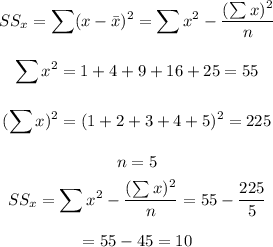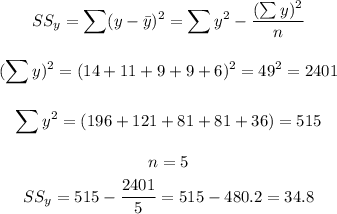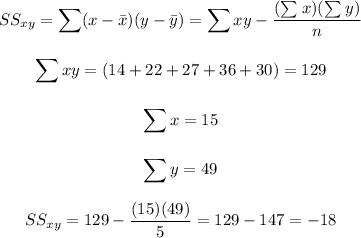SOLUTION
Given the values in the table, the following are the solutions to the questions.
Question A: SSx, SSy and SSxy
To get SSx:

To get SSy:

To get SSxy:

Question b: Calculate r
![\begin{gathered} r=\frac{SS_(xy)}{\sqrt[]{SS_x.SS_y}} \\ r=-\frac{18}{\sqrt[]{(10)(34.8)}}=\frac{-18}{\sqrt[]{348}}=-0.9649 \end{gathered}](https://img.qammunity.org/2023/formulas/mathematics/college/urazn4xgr1bo4f0avccwpecqff3ysjime0.png)
Given the value gotten above, I will need to calculate the critical value using the critical value table to ascertain if there is enough evidence.

Using the critical value table to get the value at significance level 0.05 and degree of freedom 3, the gotten value gives 0.878 i.e, 0.878 or -0.878. Since the value of r of -0.9649 falls within range of -0.878, we reject the null hypothesis. Hence, there is sufficient evidence to support that the linear correlation between x and y exists.
Question c: Yes, the linear correlation exists between x and y. We then construct the least squared line.
![\begin{gathered} y^(\prime)=a+bx \\ \text{where b = slope =}(SS_(xy))/(SS_x) \\ SS_(xy)=-18 \\ SS_x=10 \\ b=(-18)/(10)=-1.8 \\ To\text{ get a} \\ a=y-\text{intercept}=\bar{y}-\bar{bx} \\ \bar{y}=\operatorname{mean}\text{ of y values} \\ \bar{y}=9.8 \\ \bar{x}=\operatorname{mean}\text{ of x values} \\ \bar{x}=(15)/(3)=5 \\ a=\bar{y}-b\bar{x} \\ a=9.8-(-1.8)(5) \\ a=9.8+9 \\ a=18.8 \end{gathered}]()
Therefore, the least squared line will be:

Question d:
The Scattered plot with the line will be: